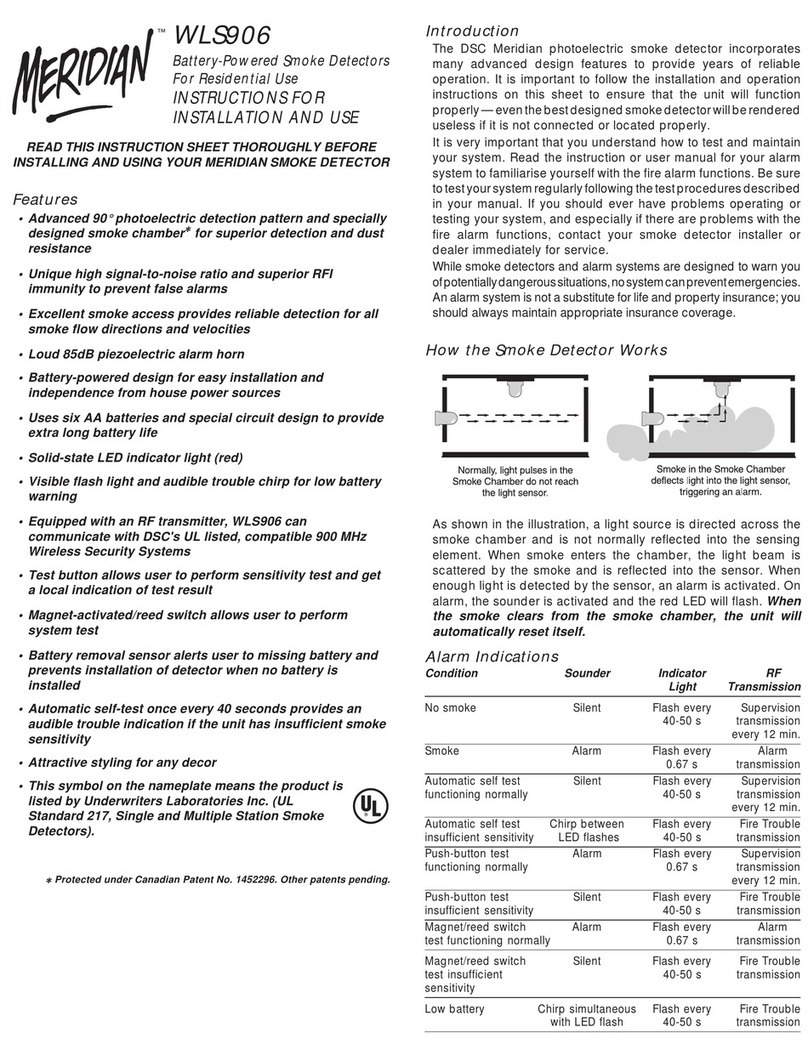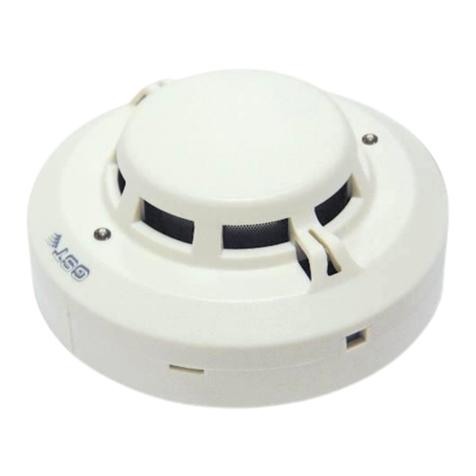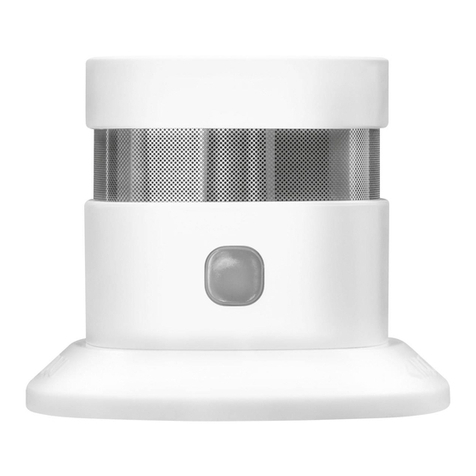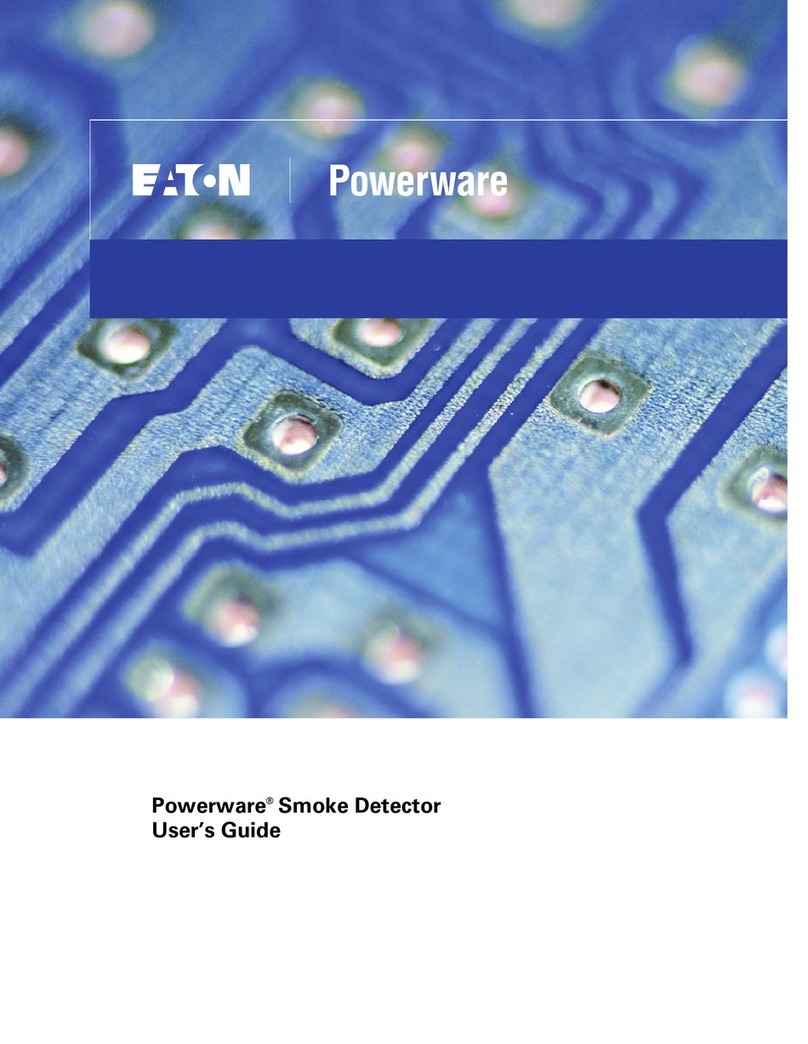Incite Fire ASD 533 User manual

NSW 02 9644 7144 QLD 07 3252 5366 VIC 03 9544 2211 WA 08 9349 2972
ASD 533
Aspirating Smoke Detector
As of production version 200619 and FW version 01.08.xx
The ASD 533 aspirating smoke detector has the task of continu-
ously taking air samples via a sampling pipe tube network from a
monitored area and feeding the samples to a smoke sensor.
The ASD 533 consists of the detector housing and a sampling pipe
tube network. The sampling pipe has several sampling holes
whose size is such that each hole extracts the same amount of air.
The sampling pipe may be I-, U-, T-, H-, or E-shaped. The sam-
pling pipe is symmetrically designed in principle. Asymmetrical
sampling pipe tube networks can also be implemented using the
“ASD PipeFlow” calculation software.
Fig. 1ASD 533
__________________________________________________________________________________________________________________
Description
Integrated in the detector housing is a high-performance fan which,
in conjunction with the sampling pipe, ensures an uninterrupted air
supply to the detector housing. Airflow monitoring detects any pipe
blockages and pipe breakages in the sampling pipe.
The ASD 533 aspirating smoke detector is part of the ASD 535
product range and is available in a version for 1 sampling tube and
1 smoke sensor without smoke level indicator. The exact designa-
tion for the aspirating smoke detector is therefore ASD 533-1. The
present document will however refer in principle to the product des-
ignation ASD 533.
The ASD 533 uses the SSD 533 smoke sensor, which has an
alarm sensitivity of 0.02%/m to 10%/m.
The ASD 533 aspirating smoke detector has four slots for addi-
tional modules. The following modules can be fitted:
•XLM 35
SecuriLine eXtended Module;
•SLM 35
SecuriLine Module;
•RIM 35
Relay Interface Module with 5 relays (max. 2
units);
•MCM 35
Memory Card Module
The ASD 533 can be connected to a higher level FACP via poten-
tial-free change-over contacts.
Fitting an XLM 35 or SLM 35 means that the ASD 533 can be ide-
ally connected to the SecuriFire and Integral fire alarm systems via
the addressable loop (with SLM also to the SecuriPro).
The RIM 35 is available as a further installation option. This mod-
ule enables the availability of all three pre-signal levels as well as
the states “smoke sensor dirty” and “LS-Ü blockage” as relay con-
tacts. The relays are also freely programmable via the
„ASD Config” configuration software.
The MCM 35 is used for storing operating data.
The ASD 533 aspirating smoke detector can be used for:
•Equipment monitoring: EDP systems, electrical distributors,
switch cabinets, etc.
•Space surveillance: EDP rooms, ultra-clean rooms, warehou-
ses, hollow floors, protection of cultural assets, transformer sta-
tions, prison cells, etc.
The ASD 533 is also deployed in areas where conventional point
detectors are normally used. Local regulations and provisions must
be observed from case to case.
The response behaviour of the ASD 533 has been tested in com-
pliance with EN 54-20, Class A, B and C.
When setting up
ASD 533 fire alarm systems, it is impo
r-
tant to take note of and observe the information and
specifications in the
“Technical description ASD 533”
.
This includes among others:
•
General Section 1
•
Planning Section 4
•
Mounting Section 5
•
Installation Section 6
•Commissioning Section 7
Opening the detector housing
To actuate the rotary snap locks use a Phillips screw-
driver (at least No. 5) to
press down firmly
towards the
housing base and then
turn
90°. The position of the lock
slit shows the current status:
•angled approx. 45° toward detector housing corner =
closed;
•angled approx. 45° toward detector housing edge =
open.
In either position the rotary snap locks
must
snap into
place.
The
housing cover
(control unit) is connected to the
main board by a
ribbon cable. Make sure the ribbon c
a-
ble is not damage when the housing cover is lifted off.

NSW 02 9644 7144 QLD 07 3252 5366 VIC 03 9544 2211 WA 08 9349 2972
Connection
Fig. 2View inside the ASD 533
Device connections on the AMB 33
The electrical connection is by means of plug-in terminals.
Term.
Signal
1
+10.5 to +30 VDC
Main power supply line
2
0 V
3
+10.5 to +30 VDC
Redundant supply line
4
0 V
5
+ supply (for OC consumers)
6
Fault output, OC (all events)
7
Alarm output, OC
8
Freely programmable, OC
9
Unused
10
Rel. 1 “(NO)”
Fault
11
Rel. 1 “(NC)”
12
Rel. 1 “COM”
13
Rel. 2 “NO”
Alarm
14
Rel. 2 “NC”
15
Rel. 2 “COM”
16
Rel. 3 “NO”
Freely programmable
17
Rel. 3 “NC”
18
Rel. 3 “COM”
19
Reset external + input
Opto-isolator input
20
Reset external -input
21
+F
(poss. available at a later date)
22
DF
23
-
24
+S
MFU 535, REK 535 connection
(available at a later date)
25
DS
26
-
UL/FM: +12.4 to +27 VDC
The “Fault” relay has picked up in the normal state
contact Te. 12/10 closed, 12/11 open (ASD 533
under voltage; no fault present).
AMB 33 internal connections
Terminal
Signal
MOT / M-
Fan -(black wire)
MOT / T
Fan tacho signal (white wire)
MOT / M+
Fan + (red wire)
OEM1 / Al-
Opto-isolator inputs OEM1
The “OEM1 /St” input can also be used for activat-
ing the day/night control (priority over triggering
from third-party detector).
OEM1 / Al+
OEM1 / St-
OEM1 / St+
•In some cases actuations may not comply with the
requirements of EN 54-20
(use only consulting with
the manufacturer).
•The OEM inputs are not line-monitored.
XLM 35, SLM 35, RIM 35 terminal assignment
The XLM 35, SLM 35 and RIM 35 terminal assignments can be
found in the corresponding data sheets T 140 088 (XLM 35),
T 131 197 (SLM 35) and T 131 196 (RIM 35).
Wiring principle
Examples of and information on the wiring principle can
be found in the Technical
description ASD 533
,
T
140 287, Sec. 6.
Using the smoke sensor
The ASD 533 ships with the smoke sensor already fitted. The
smoke sensor has to be removed from the detector housing for the
installation of the ASD (release the two lock clamps); however it
should be left inside its protective packaging until the definitive
commissioning. The definitive installation is carried out as de-
scribed below, see Fig. 3.
•Always leave the smoke sensor inside its protective
packaging until it is ready to be installed definitively in
the detector housing.
•
Depending on the circumstances (e.g. long period of
time between mounting and commissioning or if the
environment is extremely dusty (construction work)),
only remove the smoke sensor from its protective
packaging and insert it definitively in the detector
housing when commissioning the ASD 533.
•
Before installing the smoke sensor check that the in-
sect protection screens are properly fitted to the
smoke sensor chamber at the air inlet and outlet.
•
The smoke sensor chamber must be absolutely free
of any dirt and/or dust. Remove any residue resulting
from mounting the detector housing.
Check the installation position when installing the smoke sensor.
The smoke sensor connector plug must face the outside of the
ASD housing. The anti-twist rib on the smoke sensor case pre-
vents an incorrect installation position.
The smoke sensor is secured inside the ASD housing using the
two lock clamps. Connect the ribbon cable supplied with the smoke
sensor to the smoke sensor (large ribbon cable connector) and to
the AMB 33 main board (small ribbon cable connector).
Smoke sensor chamber II in the housing base cannot be used (air
duct is blocked).
Bottom part of detector box
3 x M20 cable screw unions
Reserve openings for cable screw unions
1 x M20 / 1 x M25
Fan unit
Air outlet
AMB 33 Main Board
Device terminals
Indicators and control elements
for commissioning
USB interface
4 x slots for additional modules
Internal connection elements
Airflow sensors
2 x mounting points for opened housing
cover (commissioning/maintenance)
4 x mounting points closed
housing cover
4 x fastening holes
Connection for sampling pipe I
Air duct II closed
Smoke sensor SSD 533 fitted
Tube inlet II closed

NSW 02 9644 7144 QLD 07 3252 5366 VIC 03 9544 2211 WA 08 9349 2972
Fig. 3Using the smoke sensor
Displays on the control unit
Several LEDs on the control unit indicate the current status of the
ASD 533.
Function / state
Operation
Alarm
Fault
Det. dusty / dirty
green
red
yellow
yellow
System Off (no voltage)
System inactive (reset external)
On
½ T
Smoke sensor Off (from FACP)
On
½ T
Idle state
On
Pipe blockage/pipe breakage,
delay running
On 1 T
Pipe blockage/pipe breakage,
fault triggered
On On
Fan tacho signal missing
On
On
Fault triggered
On
On
Pre-signal 1
On
2 T
Pre-signal 2
On
1 T
Pre-signal 3
On
½ T
Alarm
On
On
Smoke sensor filter fault
On
2 T
Smoke sensor dusty
On
1 T
Smoke sensor dirty
On
½ T
Smoke sensor fault
On
On
Lamp test (press “Reset” 10 s)
1 T
1 T
1 T
1 T
No fault triggered (triggers only after delay time has
expired “Fault” continuously lit).
T
= flashing display; ½ s cycle / 1 s cycle / 2 s cycle
Displays on the Main Board AMB 33
The AMB 33 has a 3-digit segment display enabling the following
outputs and displays:
•flashing, point and AL = auto-learning running;
•flashing, point and Fr = filter replacement is running;
•flashing point and continuously lit point = day/night control ac-
tive;
•switch position E= event memory E01 to E99;
•switch position F= firmware version;
•press “UP” key = set configuration A11 to X03;
•switch position V= airflow values (airflow rate);
•flashing 000 = invalid entry;
•flashing U- - =initial reset is running;
•flashing IA1,IF1,IP1,IE1 = test trigger is activated.
Programming
The ASD 533 has switch positions, which are configured with per-
manently assigned parameters:
•Normative system limits according to EN 54-20, Class A to C,
positions A11 to C31;
•Non-normative system limits, positions W01 to W44;
•Configurable positions for settings after using “ASD PipeFlow”
and/or “ASD Config” or SecuriPro, SecuriFire or Integral FACP
(SLM 35 / XLM 35), X01 to X03.
The parameters are saved at the factory with values for
compliance with EN
54-
20. Changing the parameters
may result in non
-compliance with EN 54-20. Re
-
programming on the
ASD 533 using “ASD
Config” may
be carried out only by the manufacturer or by persons
under the supervision of and trained by the manufacturer.
Switch positions on the Main Board AMB 33
Pos.
Range / Display
Purpose
A
A11
acc. to EN 54-20, Class A
b
b11 /b21
acc. to EN 54-20, Class B
C
C11 /C21 /C31
acc. to EN 54-20, Class C
d
Polling (RE)
Setting (SE)
on /T/R/oFF
on = On / oFF = Off
T= filter service life
R= filter replacement
ch1 = channel I
E
E01 to E99
G00 to G99
Event memory E01 –E99
Event group G00 –G99
F
F00 to F99 (3 x)
Displays firmware version
I
IA1
IF1
IP1
IE1
Trigger; Test alarm (IA1)
Test fault (IF1)
Test pre-signal (IP1)
Test alarm 2 (IE1)
o
o00
Logs off additional modules
(optional modules)
T
Y10 to Y99 /M01 to M12
d01 to d31 /H00 to H23
M00 to M59
Polling (RE) and setting (SE)
the date and time
U
U01
Executes initial reset
V
V01, from 000 to 255
Airflow rate output in %
W
W01 to W44
non-normative
X
X01 to X03
configurable
The table only lists the available switch positions. For in-
formation on the input procedure please refer to the
Technical
description, T 140 287, Sec. 8.3.
Anti-twist rib
Flat cable
Smoke sensor chamber I
Connection for
smoke sensor
Insect protection
screen
Lock clamp
Lock clamp
Smoke sensor
SSD 533
AMB 33
Smoke sensor chamber II not used
Air duct II closed

NSW 02 9644 7144 QLD 07 3252 5366 VIC 03 9544 2211 WA 08 9349 2972
System limits without “ASD PipeFlow” calculation
The system limits apply to the planning without using the
“ASD PipeFlow” calculation software. There are two areas, with the
following meaning:
•Normative system limits compliant to EN 54-20, Class A to C,
Switch positions A11 to C31;
•Non-normative system limits,
Switch positions W01 to W44.
Normative system limits
Stored under switch positions A11 to C31 are values which are
necessary in terms of alarm response sensitivity and airflow moni-
toring for compliance with EN 54-20 Class A to C. The switch posi-
tion designation is deciphered as follows:
•First digit
Response class A,b,Ccompliant to EN 54-20;
•Second digit
System limit 1,2,3(pipe topology);
•Third digit
Number of tube networks 1, (only 1 possible).
Example:
b21
Response
class b/ system limit 2/
1sampling pipe tube network.
Non-normative system limits
Switch positions W01 to W44 contain system limits which fulfil only
the alarm response sensitivity compliant with EN 54-20 Class A to
C, but not the normative limits with regard to airflow monitoring. As
they are identical with the system limits A11 to C31 in terms of
tube topology (tube network length, number of sampling holes), the
switch positions W01 to W44 are also included in the tables below.
For more details of switch positions W01 to W44 with regard to air-
flow monitoring, please refer to the Technical description,
T 140 287, Chap. 4.4.4.4.
Switch positions W01 to W44 are to be used only after
prior consultation with the manufacturer. The airflow
monitoring values stored under those switch positions are
not
tested in accordance with EN. For
more information
on using the table of system limits, please refer to the
Technical
description T 140 287,Sec.
4.4.4.3 and
4.4.4.4.
Table of system limits for planning without “ASD PipeFlow” calculation
Compliant with EN 54-20, Class A (highly sensitive)
Shape
System limit
Switch position
compliant with
EN 54-20
Switch position
non-norm
compliant
Alarm threshold
(%/m)
Distance from
ASD to last
T-piece/cross
Max. distance
from ASD to
furthest
sampling hole
Number of
sampling holes
per sampling
branch
Max. total
length of
sampling pipe
I
1
A11
W01 –W04
0.03
---
50 m
1 – 7
50 m
U / T
1
A11
W01 –W04
0.03
1 – 20 m
40 m
1 – 4
80 m
H
1
A11
W01 –W04
0.03
1 – 20 m
40 m
1 – 2
160 m
E
1
A11
W01 –W04
0.03
1 – 20 m
40 m
1 – 3
120 m
Compliant with EN 54-20, Class B (sensitive)
I
1
b11
W09 –W12
0.09
---
50 m
1 – 7
50 m
2
b21
W17 –W20
0.06
---
70 m
5 – 9
70 m
U / T
1
b11
W09 –W12
0.09
1 – 20 m
40 m
1 – 3
80 m
2
b21
W17 –W20
0.06
1 – 20 m
55 m
3 – 5
110 m
H
1
b11
W09 –W12
0.09
1 – 20 m
35 m
1 – 2
140 m
2
b21
W17 –W20
0.06
1 – 20 m
45 m
2 – 3
180 m
E
1
b11
W09 –W12
0.09
1 – 20 m
40 m
1 – 2
120 m
2
b21
W17 –W20
0.06
1 – 20 m
50 m
2 – 3
150 m
Compliant with EN 54-20, Class C (standard)
I
1
C11
W25 –W28
0.8
---
40 m
1 – 5
40 m
2
C21
W33 –W36
0.35
---
70 m
3 – 9
70 m
3
C31
W41 –W44
0.13
---
80 m
7 – 12
80 m
U / T
1
C11
W25 –W28
0.8
1 – 20 m
30 m
1 – 3
60 m
2
C21
W33 –W36
0.35
1 – 20 m
60 m
3 – 5
120 m
3
C31
W41 –W44
0.13
1 – 20 m
70 m
5 – 8
140 m
H
1
C11
W25 –W28
0.8
1 – 25 m
35 m
1 – 2
140 m
2
C21
W33 –W36
0.35
1 – 25 m
45 m
2 – 3
180 m
3
C31
W41 –W44
0.13
1 – 25 m
50 m
3 – 4
200 m
E
1
C11
W25 –W28
0.8
1 – 20 m
30 m
1 – 2
90 m
2
C21
W33 –W36
0.35
1 – 20 m
50 m
2 – 3
150 m
3
C31
W41 –W44
0.13
1 – 20 m
55 m
3 – 5
165 m

NSW 02 9644 7144 QLD 07 3252 5366 VIC 03 9544 2211 WA 08 9349 2972
Sampling holes for planning with “ASD PipeFlow” calculation
The tables below show the corresponding hole diameters for the numbers in Fig. 4 depending on the number of sampling holes per sampling
branch.
I-shaped sampling pipe
Number of sam-
pling holes in the
sampling branch
Hole diameter in mm for the sampling hole number as of ASD
1 2 3 4 5 6 7 8 9 10 11 12
1
5.0
2
4.0
5.0
3
4.0
4.0
5.0
4
3.5
3.5
4.0
5.0
5
3.5
3.5
3.5
4.0
5.0
6
2.5
2.5
2.5
2.5
3.0
5.0
7
2.5
2.5
2.5
2.5
2.5
2.5
5.0
8
2.5
2.5
2.5
2.5
2.5
2.5
2.5
5.0
9
2.5
2.5
2.5
2.5
2.5
2.5
2.5
2.5
5.0
10
2.0
2.0
2.0
2.5
2.5
2.5
2.5
2.5
3.0
7.0
11
2.0
2.0
2.0
2.0
2.5
2.5
2.5
2.5
2.5
4.0
7.0
12
2.0
2.0
2.0
2.0
2.0
2.0
2.5
2.5
2.5
2.5
4.0
7.0
U/T-shaped sampling pipes
Number of sam-
pling holes per
sampling branch
Hole diameter in mm for the sampling
hole number as of ASD
1
2
3
4
5
6
7
8
1
5.0
2
4.0
5.0
3
4.0
4.0
5.0
4
4.0
4.0
4.0
5.0
5
4.0
4.0
4.5
5.0
6.5
6
3.0
3.0
3.5
3.5
4.0
6.5
7
2.5
3.0
3.0
3.5
3.5
4.0
6.5
8
2.5
2.5
3.0
3.0
3.5
3.5
3.5
7.0
H/E-shaped sampling pipes
Number of sam-
pling holes per
sampling branch
Hole diameter in mm for the sampling
hole number as of ASD
1
2
3
4
5
1
5.0
2
4.0
5.0
3
4.0
4.0
5.5
4
3.0
3.0
3.5
5.5
5 (E-shaped only)
2.5
3.0
3.0
3.0
6.0
Fig. 4Size of sampling holes
I-shaped
U/T-shaped
H-shaped
E-shaped
1
1
1
2
2
2
3
3
3
4
4
4
5
5
5
4
4
3
3
2
2
1
1
1
1
2
2
3
3
4
4
12345678910 11 12
8
8
7
7
6
6
5
5
4
4
3
3
2
2
1
1
1 to 12 = Sampling hole number

NSW 02 9644 7144 QLD 07 3252 5366 VIC 03 9544 2211 WA 08 9349 2972
Configuration options, Table A:
The criteria below can be set separately with the day/night control activated. Configuration changes are saved on X01 to X03.
Sector
•
Parameter
Default
Setting
Area Resolution /
Levels
Saving after
change
Alarm 2
•Alarm 2 On / Off
Off
Off / On
X01 –X03
•Sensitivity (always at least 20% above alarm)
1%/m
–10%/m
0.0002%/m
X01 –X03
•Alarm 2 delay
2 s
0 s –60 s
1 s
X01 –X03
•Alarm 2 latching
On
On / Off
X01 –X03
•Hold time for area switchover (Al 2 to Al)
20
10 –250
1 s
X01 –X03
Alarm (EN 54-20)
•Alarm threshold
C11
0.02 –10%/m
0.0002%/m
X01 –X03
•Smoke level value averaging (number)
4
1 – 10
1
X01 –X03
•Alarm delay (UL/ULC max. 30 s)
2 s
0 s –60 s
1 s
X01 –X03
•Alarm cascading
Off
Off / On
X01 –X03
•
Alarm latching
On
On / Off
X01 –X03
Pre-signal
•Pre-signal 1 On / Off
On
On / Off
X01 –X03
•Pre-signal 2 On / Off
On
On / Off
X01 –X03
•Pre-signal 3 On / Off
On
On / Off
X01 –X03
•Pre-signal 1 (100% = alarm threshold)
30%
10 –90%
10%
X01 –X03
•Pre-signal 2 (100% = alarm threshold)
50%
VS 1 + 10 –90%
10%
X01 –X03
•Pre-signal 3 (100% = alarm threshold)
70%
VS 2 + 10 –90%
10%
X01 –X03
•Pre-signal delay (VS 1 –VS 3)
2 s
0 s –60 s
1 s
X01 –X03
•Pre-signal latching
Off
Off / On
X01 –X03
Smoke sensor dust/soiling
•Smoke sensor dust On / Off
On
On / Off
X01 –X03
•Smoke sensor soiling On / Off
On
On / Off
X01 –X03
•Dust threshold (% of Al)
50%
5 – 60%
5%
X01 –X03
•Soiling threshold (% of Al)
75%
65 –100%
5%
X01 –X03
•Dust latching
On
On / Off
X01 –X03
•Soiling latching
On
On / Off
X01 –X03
•
Smoke sensor fault delay
30 s
0 s –60 s
1 s
X01 –X03
Airflow monitoring
•LS-Ü pipe blockage On / Off
On
On / Off
X01 –X03
•LS-Ü pipe breakage On / Off
On
On / Off
X01 –X03
•LS-Ü sensitivity (applies to A01 to C31)
±20%
±1 –±70%
± 1%
X01 –X03
•LS-Ü value averaging (number)
20
1 – 30
1
X01 –X03
•LS-Ü delay (applies to A01 to C31)
300 s
10 s –3600 s
1 s
X01 –X03
Stored under switch positions W01 to W44 are increased values which are not tested for EN compliance (see Technical descrip-
tion, T 140 287,Sec. 4.4.4.4).
Configuration options, Table B:
The following criteria apply to the entire ASD 533. Configuration changes are stored in connection with the adjustments from Table A, likewise
on one of the user configurable switch positions X01 to X03.
Sector
•
Parameter
Default
Setting
Area
Resolution /
Levels
Saving after
change
Autolearning
•Autolearning On / Off
Off
On
X01 –X03
•Autolearning duration
3 days
1 min to 14 days
min, h, days
X01 –X03
•Autolearning factor (of measured Al threshold)
1.5
1.1 –10 x
X01 –X03
Day/night control / weekday control
•Day/night control On / Off Off
Off / clock / FACP /
input “OEM1 /St”
X01 – X03
•Day start time (only with “Clock”)
06:00
00:00 –24:00
1 min
X01 –X03
•Night start time (only with “Clock”)
20:00
00:00 –24:00
1 min
X01 –X03
•Weekday control (only with “Clock”)
On
Mon to Sun
Days
X01 –X03
General faults
•Lithium battery / clock fault
On
On / Off
X01 –X03
Deactivate / switch off sensor
•Smoke sensor I
On
On / deactivated
X01 –X03

NSW 02 9644 7144 QLD 07 3252 5366 VIC 03 9544 2211 WA 08 9349 2972
Configuration options, Table C:
Independent configurations. These configurations can be changed independently of the switch position on the ASD 533.
Sector
•
Parameter
Default
Setting
Selection
Time
•Year, month, day, hour, minute
---
minutes –year
Relay / OC output / reset key / various
•Relay 3 and OC output 3, AMB 33
freely programmable
in accordance with
“Configuration options
relay allocation”
•Relay 1, 1st RIM 35
Pre-signal 1
•Relay 2, 1st RIM 35
Pre-signal 2
•Relay 3, 1st RIM 35
Pre-signal 3
•Relay 4, 1st RIM 35
Smoke sensor dirty
•Relay 5, 1st RIM 35
Pipe blockage sampling pipe
•Relay 1, 2nd RIM 35
freely programmable
•Relay 2, 2nd RIM 35
•Relay 3, 2nd RIM 35
•Relay 4, 2nd RIM 35
•Relay 5, 2nd RIM 35
•Reset key On / Off
On
On / Off
•Heating control, subsequent heating time
2 min
1–60 min
•MCM setting, recording interval
1 s
1–120 s
•MCM smoke peak value memory
Off
Off / On
•Carry out new initial reset
---
On / Off
•Smoke sensor mode of operation (smoke sensor I) SSD/DMB
SSD/DMB or OEM inputs
(individual or in combination)
Switched off
•Isolate smoke sensor (smoke sensor I)
Normal operation
Isolate / normal operation
•Filter monitoring (smoke sensor I)
Off
Off / On
•Filter service life
6 months
1–24 months
•Read out operation time
---
months / days
•Filter replacement
---
start / finish
Relay allocation configuration options:
The following criteria can be programmed on a maximum of 11 relays (1 AMB 33 unit with ASD 533-1 and ASD 535-3, 5 units with 1st RIM 35,
5 units with 2nd RIM 35):
Smoke sensor / LS-Ü
General
Smoke sensor alarm
Fan fault
Pre-signal 1
Operating voltage fault
Pre-signal 2
Initial reset fault
Pre-signal 3
Lithium battery / clock fault
Smoke sensor dusty
Smoke sensor soiled
Smoke sensor fault
Pipe blockage sampling pipe
Pipe breakage sampling pipe
Heating control
Alarm 2
The criteria can also be allocated using the OR function (e.g. smoke sensor dust or soiling together on one relay).

NSW 02 9644 7144 QLD 07 3252 5366 VIC 03 9544 2211 WA 08 9349 2972
Commissioning
When commissioning the ASD 533, it is necessary to perform an
initial reset to automatically adjusting the airflow monitoring on the
connected sampling pipe.
If the ASD 533 is operated without “ASD PipeFlow” calculation, the
commissioning can be carried out directly on the ASD 533 using
the “EasyConfig” process.
For projects in which the ASD PipeFlow calculation software was
used or in which customer-specific adjustments to the device con-
figuration are required, use the “ASD Config” configuration soft-
ware.
Startup
Before the ASD 533 is switched on, make sure all the
precautions required for its operation have been taken
(see also T
140 287, Sec. 7.1).
•
Sampling pipe correctly laid and connected;
•Smoke sensor removed from protective packaging,
mounted and connected;
•
Isolation strip on the lithium battery (AMB 33) r
e-
moved.
Startup sequence and procedure:
1. Switch on supply voltage (FACP); the next procedure can be
carried out while the fan is ramping up to its definitive speed
(takes about 100 s). The system is immediately armed for
alarm.
2. “EasyConfig”: Select the required switch position for opera-
tion in accordance with the “Table of system limits” (e.g.
“b21”) see also under “Re-programming”.
-or:
„ASD Config”: after making adjustments to the configuration
(alarm threshold acc. to ASD PipeFlow, other criteria acc. to
Tables A and B) select switch position “X01”, “X02” or “X03”.
3. Set date and time via AMB 33 on “EasyConfig” or from
“ASD Config” (adopt settings from PC).
4. After a minimum waiting time of 5 min after switch-on, carry
out an initial reset (possible only via AMB 33) see also un-
der „Initial reset“.
5. The ASD 533 is now ready for operation.
Re-programming
Example: Response grade B, system limit 2, switch position requi-
red b21.
Measure
Display Procedure, remarks
Switch positions W01 to W44 are to be used only after
prior consultation with the manufacturer. The airflow
monitoring values stored under those switch positions are
not tested in accordance with EN.
1.
Press the “UP
”
key
flashing
C31
•
Displays the default
setting
2. Press “UP”key
twice until di
s-
play shows b
in succession A/b
•Displays the switch
position group b
3. Press the “OK”
key
b11
•Displays the smallest
possible position in
group b
4. Press the “UP”
key until di
s-
play shows b21
alternatively b11 /
b21
•
Displays the possible
positions in group b
5. Press the “OK”
key
flashing b - -
(approx. 4x)
•New setting is pro-
grammed
6. Check: Press
the “UP”key
flashing b21
•
Displays the new set-
ting
Initial reset
Measure
Display Procedure, remarks
Before carrying out an initial reset –i.e. after switching on
the
ASD 533 – make sure you observe a
waiting time of
at least 5
min.
1. Press the “UP”
key
flashing C31 or
others
•Displays the default
setting or the installa-
tion-
specific switch
position
2. Press the “UP”
key several
times until di
s-
play shows U
in succession Ato
U
•Displays the switch
position group U
3. Press the “OK”
key
U01
•
Displays initial reset
On
4. Press the “OK”
key again
flashing U - -
(5 to max. 120 s)
•Initial reset in pro-
gress
5. Wait
flashing point
(watchdog indica-
tor)
•Initial reset com-
pleted
Filter replacement
When filter monitoring is activated and after expiry of the config-
ured filter service life, a “Filter fault (service life exceeded)” fault is
triggered. To remedy, the filter element in a filter-box or dust filter
unit must be replaced. When the expired filter service life (read out
via EasyConfig switch position d>RE) is periodically checked, the
replacement can take place before the fault is triggered.
For an activated filter replacement the ASD is set to the
“
isolate
” state. This insures that during the replacement
work falling dust particles from the filter element do not
cause a false alarm.
When the ASD 533 housing is closed, the “Start filter replacement”
function can be activated by means of the “Reset” key (provided
the filter monitoring is activated). To do so, press the key longer
than 15 s (attention: lamp test after 10 s). After 15 s the filter re-
placement is started and indicated by switching to the “Isolate”
state (Fault and LED “Fault”). When the “Reset” key is deactivated
(via ASD Config), the “Start filter replacement” function is not ac-
cessible.
After the filter has been replaced, the “Filter replacement” proce-
dure is completed by pressing the “Reset” key on the ASD. This
cancels the “Isolate” state and resets the fault on the ASD. “Filter
service life” monitoring is restarted at 0.
The filter replacement can also be started via EasyConfig switch
position d>SE. For information please refer to Technical Descrip-
tion T 140 287, Section 7.8.
Measurements / commissioning protocol
Carry out the following measurements:
•Measure voltage at terminals 1 (+), 2 (-) (also terminals 3 and 4
in the case of a redundant voltage supply) target value =
12.3 to 13.8 (in 12 VDC operation) and 21.6 to 27.6 VDC (in
24 VDC operation)
•Airflow value in switch positions V(see also Technical descrip-
tion, T 140 287, Sec. 7.6.1).
The commissioning protocol is like a personal history of the
ASD 533 and should therefore be filled out conscientiously and
completely and stored in the ASD 533. If required, a copy can be
made and stored in the installation dossier.

NSW 02 9644 7144 QLD 07 3252 5366 VIC 03 9544 2211 WA 08 9349 2972
Checking fault and alarm release
Test
Procedure
Action
Block or switch off the fire incident control and remote
alerting on superordinate FACP.
Check airflow
monitoring
Tape
over the
sampling ho-
les (adhesive
tape); the
number de-
pends on the
pipe configu-
ration.
•
As soon as the resulting
change in airflow rate exceeds
±20% (which can also be
checked using switch position
V), the “Fault” LED begins to
flash.
•Once the LS-Ü delay (300 s)
has elapsed, the ASD triggers
a fault fault on FACP .
Check alarm
r
elease
Impose
smoke at the
maintenance
sampling hole
or sampling
hole.
•ASD triggers an alarm
alarm on FACP; check for cor-
rect alarm transmission (zone/
range release) on the FACP.
•Any pre-signals will also re-
lease.
Reset the ASD 533 between each check (please note: reset-
ting the ASD does not reset the FACP).
Alternatively, this control can also be performed using the “Test
trigger” function from EasyConfig switch position I.
Article numbers and spare parts
Short designation
Article number
Aspirating smoke detector ASD 533-1
11-2000001-01-XX
Replacement smoke sensor SSD 533
11-2200006-01-XX
SecuriLine eXtended line module XLM 35
11-2200003-01-XX
SecuriLine module SLM 35
4000286.0101
Relay interface module RIM 35
4000287.0101
Memory card module MCM 35
4000285.0101
SD memory card (industrial version)
11-4000007-01-XX
USB cable, 4.5 m
4301248
Main board AMB 33-1
11-2200004-01-XX
BCB 35 (without smoke level indicator)
4301220.0101
Aspirating fan unit AFU 35, complete
4000299
Airflow sensor AFS 35
4000300
Insect protection screen IPS 35 (set of 2)
11-2300012-01-XX
Lithium battery
11-4000002-01-XX
Cable screw union
M20 (set of 10)
11-4000003-01-XX
M25 (set of 10)
11-4000004-01-XX
Adapter US cable screw union AD US M-Inch
11-2300029-01-XX
Universal module support UMS 35
4301252.0101
Technical description ASD 533
T 140 287
Material for the sampling pipe
T 131 194
Commissioning protocol
T 140 299
Data sheets
XLM 35
T 140 088
SLM 35
T 131 197
RIM 35
T 131 196
MCM 35
T 131 195
AFU 35 installation instructions
T 131 200
Declaration of performance
www.securiton.ch/declaration-of-performance
Dimensioned drawing
Fig. 5Detector housing dimensioned drawing
Position of M25
screwed cable glands
and air outlet
Position
of air outlet
Space requirement
for offset mounting
of the housing cover
for commissioning
and maintenance
27
(76)
27
35
22
148
57
23
(171)
348 ca. 26
(397)
265
114
35 44 74
31
225
20 20
310 1919
10
6,5

NSW 02 9644 7144 QLD 07 3252 5366 VIC 03 9544 2211 WA 08 9349 2972
Technical data
Type
ASD 533-1
Supply voltage range
10.5 to 30 (UL/FM = 12.4 to 27)
VDC
Maximum power consumption,
in 12 VDC operation
in 24 VDC operation
Typical
measured at
10.5 VDC
18 VDC
24 VDC
ASD 533-1
Quiescent/fault
approx. 265
approx. 160
approx. 130
mA
Alarm
approx. 340
approx. 210
approx. 160
mA
additionally with 1 RIM 35 unit (all relays triggered)
approx. 15
approx. 10
approx. 7
mA
additionally with 2 RIM 35 units (all relays triggered)
approx. 30
approx. 20
approx. 14
mA
additionally with XLM 35 / SLM 35
approx. 20
approx. 10
approx. 5
mA
additionally with MCM 35
approx. 25
approx. 15
approx. 10
mA
Switch-on current peak
(caused by EMC protection elements on the ASD supply input)
approx. 5
A
for max. 1
ms
Sampling pipe length
see T 140 287,Sec. 4.2.1
Sampling pipe diam., typical (inner/outer)
Ø20 / 25
mm
Max. number of sampling holes
see T 140 287,Sec. 4.2.1
Sampling hole diameter
Ø2 / 2.5 / 3 / 3.5 / 4 / 4.5 / 5 / 5.5 / 6 / 6.5 / 7
mm
Response range (Sensitivity: Alarm 0,02 %/m –10 %/m, pre-signals 0,002 %/m –9 %/m)
EN 54-20, Class A, B, C
Protection type acc. to IEC 60529 / EN 60529
54
IP
Ambient conditions acc. to IEC 60721-3-3 / EN 60721-3-3
3K5 / 3Z1
class
Extended ambient conditions:
•Detector housing temperature range
–20 –+60 (UL max. +40)
°C
•Sampling pipe temperature range
–20 –+60
°C
•Max. permissible temperature fluctuation in detector housing and sampling pipe operation
20
°C
•Max. permissible storage temperature for detector housing (without condensation)
–20 –+70
°C
•Ambient pressure difference between detector housing and sampling pipe (sampling holes)
must be identical
•Humidity ambient condition for detector housing (transient without condensation)
95
% rel. hum.
•Humidity ambient condition detector housing and sampling pipe (continuous)
70
% rel. hum.
Max. loading capacity, relay contact
50 (UL max. 30)
VDC
1
A
30
W
Max. loading capacity per OC output (dielectric strength 30 VDC)
100
mA
Plug-in terminals
2.5
mm²
Cable entry for cable Ø
Ø 5 –12 (M20) / Ø 9 –18 (M25)
mm
Sound pressure level
34
dB (A) / 1 m
Housing material
ABS blend, UL 94-V0
colour
grey 280 70 05 / anthracite violet 300 20 05
RAL
Approvals
EN 54-20 / FM 3230-3250 / UL 268 7th Ed / ULC-S529 4th Ed
Dimensions (W x H x D)
265 x 397 x 148
mm
Weight
3,255
g
Power consumption at maximum permitted voltage drop in the electrical installation (guideline value for calculating the conductor
cross-section).
May cause the protective circuit to actuate immediately in the case of power supplies with overload protective circuits (primarily
in devices with no emergency power supply and output current of < 1.5 A).
Lower or higher temperature ranges are also possible subject to consultation with the manufacturer. The manufacturer must be
consulted if used in the condensation range.
Table of contents
Other Incite Fire Smoke Alarm manuals
Popular Smoke Alarm manuals by other brands
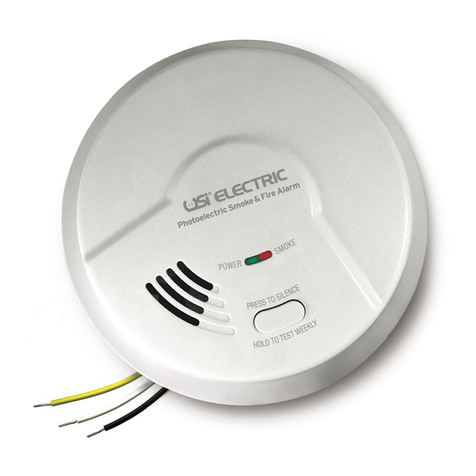
Universal Security Instruments
Universal Security Instruments MP117 instructions
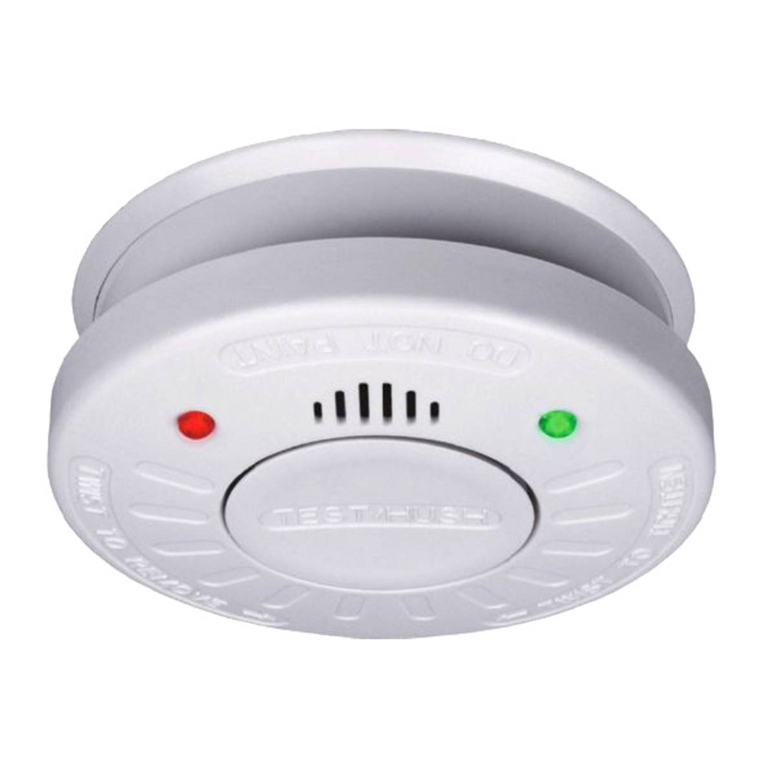
Smartwares
Smartwares RM520 user manual

Vision
Vision ZS 6101 IN Installation & operation manual
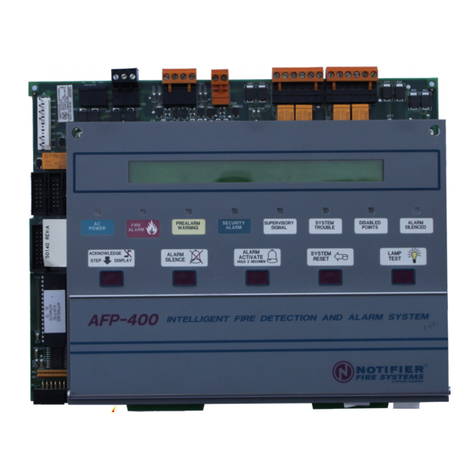
Notifier
Notifier AFP-400 Product installation guide

Regin
Regin SDD-OE65-RACM Instruction
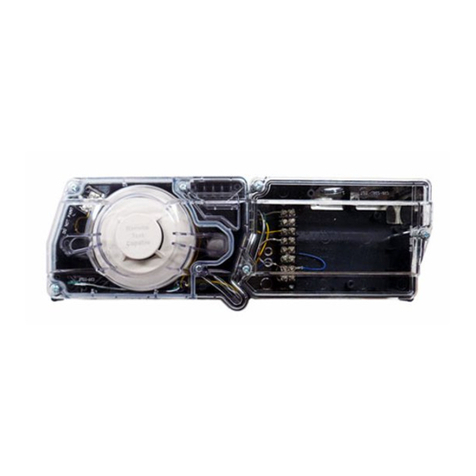
Honeywell
Honeywell Silent Knight SK-Duct Installation and maintenance instructions
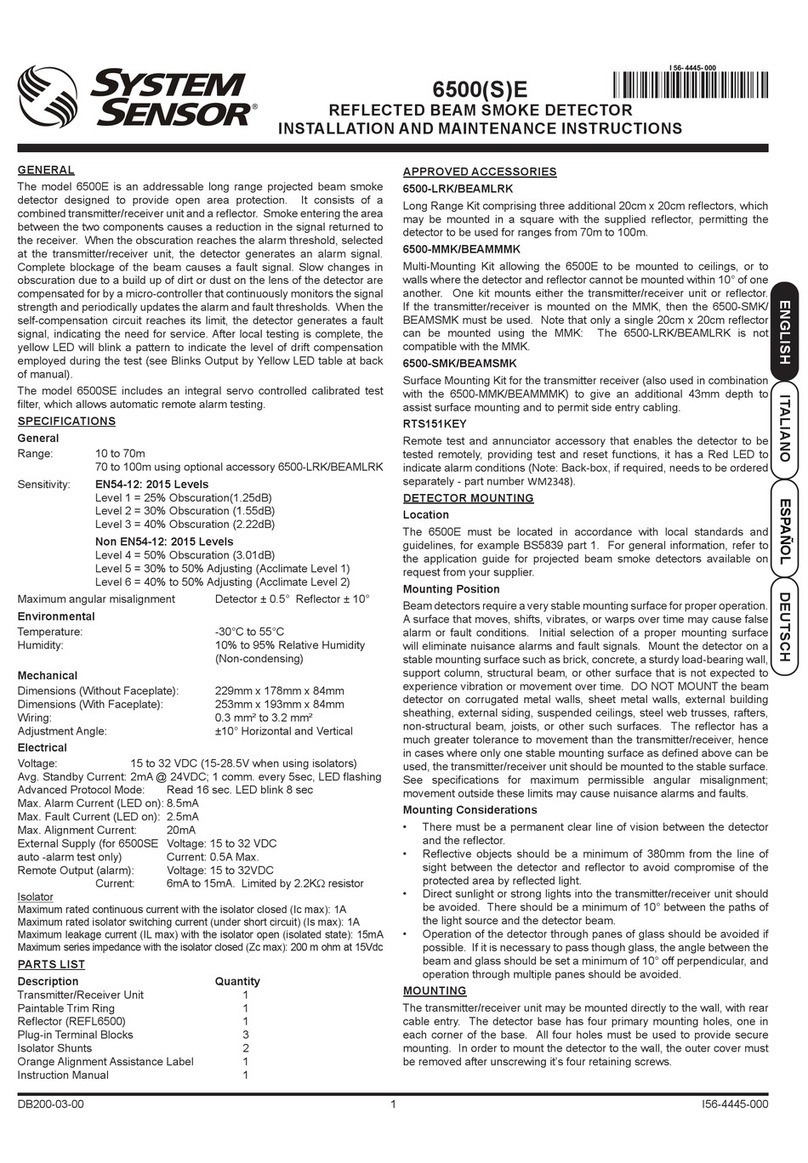
System Sensor
System Sensor 6500E Installation and maintenance instructions
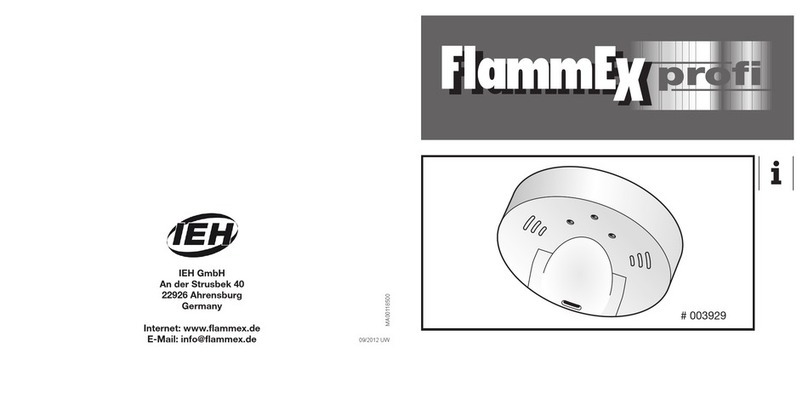
IEH
IEH FlammEx profi User instructions
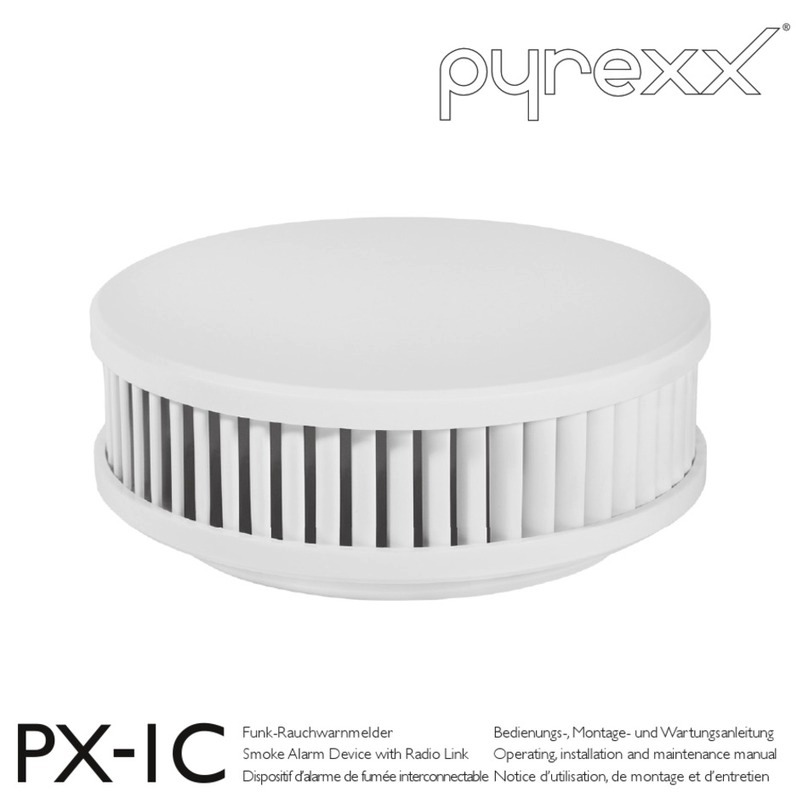
pyrexx
pyrexx PX-1C Operating, installation and maintenance manual

Greenheck
Greenheck Smoke Dampers SMD-401M Specifications
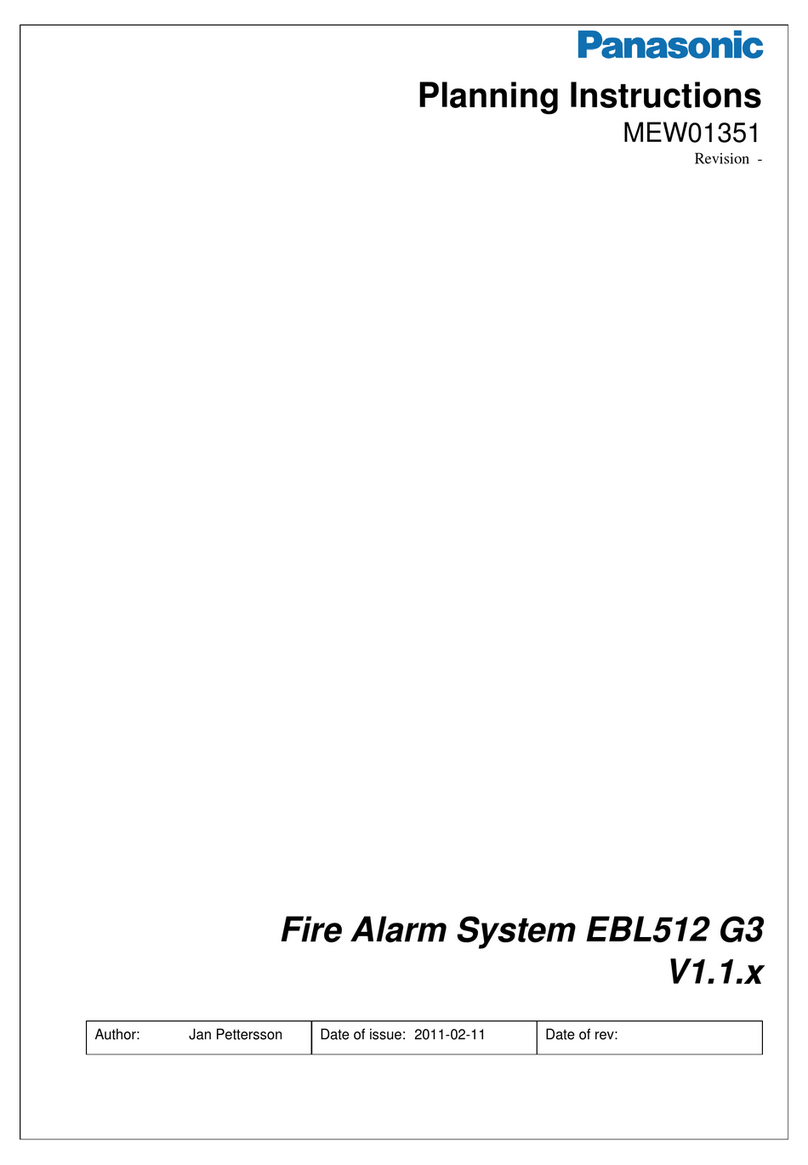
Panasonic
Panasonic MEW01 351 Planning guide

Universal
Universal SS-775 instructions


